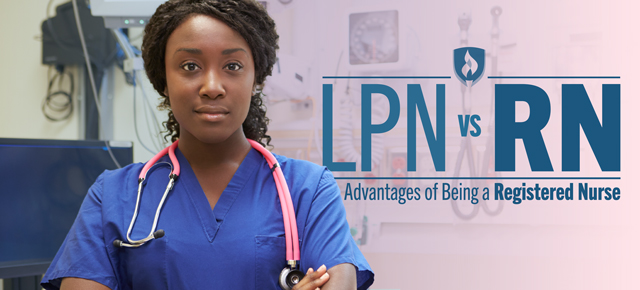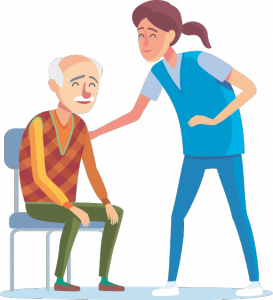- Registered Nurse
- Licensed Practical Nurse (LPN) or Licensed Vocational Nurse (LVN)
- Certified Nursing Assistant or Certified Nurse Aide
- Occupational Therapist
- Physical Therapist
- Respiratory Therapist
- Speech Therapist
- Dietitian
- Social Worker
One of the best things about being a health care professional is that you work as part of a team. Each team member has a different kind of education and expertise. It’s interesting and exciting to learn how each specialty contributes to providing excellent patient care.
Let’s look at some of the specialists you’ll work with. All health care professionals are licensed by their state. Each position has specific educational requirements and unique responsibilities. As you read about each role, you’ll come to understand why all of them are important in helping the patient achieve the best outcome.
You’re probably already familiar with what some of your colleagues do. Let’s start with a quick review of nursing team members.
Nursing Team Members
- 1
Registered Nurse:
A 2-year associate’s degreeis required to become a registered nurse (RN)
A Registered Nurse (RN) has at least a two-year associate’s degree, and many RNs have a four-year bachelor’s degree. An RN must pass the National Council Licensure Examination (NCLEX-RN), which is accepted in all states. RNs work in all settings as staff nurses, administrators, and educators.
The RN has extensive responsibilities including supervising Licensed Practical Nurses (LPNs)/Licensed Vocational Nurses (LVNs) and Certified Nursing Assistants (CNAs). Other duties include the following:
- Assessing patients’ health problems
- Taking orders from physicians
- Administering medications and starting IVs
- Monitoring patient progress and reporting changes to physicians
- Providing patient and family education including discharge instructions
- Charting and updating medical records

A Registered Nurse at Rasmussen College (“LPN vs. RN: The Advantages of Being a Registered Nurse”) - 2
Licensed Practical Nurse or Licensed Vocational Nurse:
A Licensed Practical Nurse (LPN) or Licensed Vocational Nurse (LVN) is a nurse who completes one year of state-approved education and passes the National Council Licensure Examination (NCLEX-PN), which is accepted in all states. An LPN/LVN works under the supervision of an RN or a doctor. In some states, an LPN/LVN can supervise CNAs.
The LPN/LVN provides basic nursing care. In some states, they can receive training to administer medications or start IVs. Responsibilities include the following:
- Monitoring patient status by taking vital signs
- Changing dressings and inserting urinary catheters
- Providing care or assisting with activities of daily living (ADLs), such as bathing, dressing, and feeding
- Reporting changes to the RN or doctor
- Charting and updating medical records
- 3
Certified Nursing Assistant or Certified Nurse Aide:
A Certified Nursing Assistant or Certified Nurse Aide (CNA) takes a state-approved program to learn basic patient care skills. Each state has requirements for the length of the program and the certification examination. After passing the CNA certification exam, the CNA is placed on the state registry. In a few states, a CNA can receive special training to become credentialed as a Certified Medication Assistant (CMA) to administer medications.
CNAs provide direct care to patients and residents. They assist with ADLs as follows:
- Cleaning and bathing patients or residents
- Helping with dressing, toileting, and eating
- Positioning and transferring
- Measuring vital signs
- Charting and updating medical records
- 4
Occupational Therapist:
An occupational therapist has a master’s degree; some of them have a doctoral degree. Besides the coursework, an internship of almost six months in a supervised clinical setting is necessary. All occupational therapists must pass the National Board for Certification in Occupational Therapy (NBCOT) and meet their state’s requirements to be licensed.
With their extensive education and training, occupational therapists are qualified to help patients who are disabled, injured, or sick learn to develop or regain their abilities to do ADLs. Their responsibilities include the following:
- Evaluating the condition and needs of patients
- Developing treatment plans with specific activities to reach goals
- Helping with pain management by employing exercises or special techniques
- Visiting a patient’s home or work settings to identify opportunities for improvement
- Selecting equipment and devices that will assist patients
- Assessing and reporting progress to the physician and other team members
- Educating the patient, family, and employer
- 5
Physical Therapist:
To become a physical therapist, at least a bachelor’s degree is required plus 30 weeks of supervised clinical experience. Every state has its own licensing requirements, but all physical therapists must pass the National Physical Therapy Examination (NPTE). After 2,000 hours of employed work experience and another examination, a physical therapist can be board certified in a specialty such as orthopedics, sports medicine, or geriatrics.
Physical therapists help patients or residents improve their movement and manage their pain. They can provide their services as part of the rehabilitation process, or they can work with patients to prevent chronic conditions from getting worse. Their responsibilities include the following:
- Diagnosing how well patients move and function
- Creating an individual care plan
- Employing exercises, stretches, and techniques such as ultrasound or heat therapy
- Determining which equipment will most benefit the patient
- Evaluating and modifying the treatment plan to reach goals
- Educating patients and their families about how to cope with the physical challenges
- 6
Respiratory Therapist:
A respiratory therapist must have a minimum of a two-year associate’s degree, and many employers prefer a four-year bachelor’s degree. Every state except Alaska requires respiratory therapists to be licensed. Certification is handled by The National Board for Respiratory Care (NBRC). First, a respiratory therapist obtains a Certified Respiratory Therapist (CRT) credential. After getting more education and experience and passing another examination, a respiratory therapist can become a Registered Respiratory Therapist (RRT).
Respiratory therapists take care of patients who have problems with breathing for a variety of reasons. Some patients have chronic conditions such as asthma or emphysema. In the hospital setting, respiratory therapists may work in the neonatal intensive care unit (NICU), taking care of premature babies who have underdeveloped lungs. Respiratory therapists may also work in emergency settings with patients who have been intubated and placed on ventilators. Typical responsibilities include the following:
- Talking to patients about their respiratory problems
- Discussing treatment options with doctors and following the doctors’ orders
- Performing tests of arterial blood gases (ABG) or lung capacity
- Administering respiratory medications and treatments
- Maintaining ventilators for patients who have been intubated or have had tracheostomies
- Educating patients and their families about their treatments and equipment
- 7
Speech Therapist:
Speech therapists, also called speech-language pathologists, need at least a master’s degree and supervised clinical experience to become licensed. Each state has particular requirements for certification. Some states require that the education take place at a school that is accredited by the Council on Academic Accreditation (CAA) branch of the American Speech-Language-Hearing Association (ASHA).
Speech therapists are able to assess and diagnose disorders related to language and swallowing. They work with patients of all ages. Children may have developmental delays, brain injury, autism, hearing loss, or a cleft palate. Adults might have Parkinson’s disease or might have had a stroke. A licensed speech therapist is qualified to perform the following:
- Evaluate a patient’s speech, language, or swallowing problem.
- Develop an individualized treatment plan.
- Teach patients how to make sounds and form words.
- Work with patients to strengthen the muscles used for swallowing.
- Educate patients, families, and teachers.
- 8
Dietitian:
1,200 hoursof supervised experience required to become a Registered Dietitian Nutritionist (RDN)
A dietitian or nutritionist goes to college for at least four years to earn a bachelor’s degree. They major in nutrition, dietetics, or clinical and public nutrition. They also have supervised clinical experience. Many have master’s degrees. Most states require dietitians to be licensed, and the process varies by state. A dietitian can choose to become a Registered Dietitian Nutritionist (RDN) by completing at least 1,200 hours of supervised experience. Many hospitals and facilities require an RDN, and some states include it as part of being licensed.
As expected, a dietitian or nutritionist does play a major role in health care. Proper diet is necessary to achieve good health and improve or manage a medical condition. A dietitian has the following responsibilities:
- Evaluating a patient’s health and dietary requirements
- Educating the patient and family on proper nutrition
- Developing meal plans that a patient is able to afford and use
- Following patients and assessing how well their meal plans are working
- Adapting meal plans as necessary
- Promoting proper nutrition in the community
- 9
Social Worker:
Social workers must have at least a bachelor’s degree and complete a supervised internship to get entry-level jobs. Some employers require a master’s degree and further supervised clinical experience. Most states have licensure requirements for social workers who work in non-clinical settings. To become a Licensed Clinical Social Worker (LCSW), a social worker is required by all states to have a master’s degree and at least two years of clinical experience and to have passed an examination.
Social workers work with patients and people in the community to help handle or solve problems in their lives. They provide counseling and identify resources that can help with the problems. LCSWs work with people who have mental or behavioral conditions. The many responsibilities of a social worker include the following:
- Assessing patients’ needs and how well they are coping in their lives
- Providing support to help patients with their stress and life changes
- Identifying community resources and referring patients to them
- Helping with such crises as abuse or neglect
- Developing groups or classes for specific issues or conditions
- Counseling patients and providing therapy
As a CNA, you may also find yourself working with other health care specialists. Depending on the setting, these professionals may have their own areas within the facility and provide frequent service, or they may come to the patient when ordered to by the physician. All of them provide direct care just as the CNA does. They can also make entries in the patient’s medical record.
Sometimes a patient or resident will need help from other team members. These important people provide services on either an ongoing or occasional basis. They’re not direct care team members, but they have significant roles for the patient.
Isn’t this a magnificent group of people?
Each of you is prepared to help your clients, patients, and residents in a unique way. Working together and with good communication, you can achieve so much more!
 By
By 



